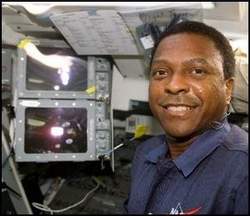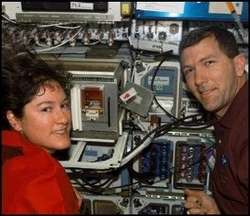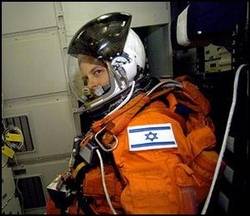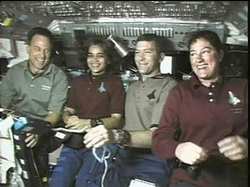STS-107 MCC Status Report #09; Thursday, January 23, 2003 -
5:00 p.m. CST
...Highlighting the investigations today for both the Blue and
Red Teams were the SOFBALL (Structures of Flame Balls) and ARMS
(Advanced Respiratory Monitoring System) experiments, although both
teams continued to support other experiments with a variety of
activities.
 Mission Specialists Michael Anderson (right) of
the Blue Team and Kalpana Chawla of the Red Team initiated runs
with the SOFBALL experiment, which is creating tiny ball-shaped
flames using hydrogen as the fuel. The tiny flames, which are
approaching some of the leanest and longest-lasting ever, are
invisible to the human eye but visible to the crew and
investigators on the ground through special video equipment. Dr.
Paul Ronney of the University of Southern California and his team
hope to discover new properties about combustion to improve engine
efficiency and fire safety, as well as reduce emissions.
Mission Specialists Michael Anderson (right) of
the Blue Team and Kalpana Chawla of the Red Team initiated runs
with the SOFBALL experiment, which is creating tiny ball-shaped
flames using hydrogen as the fuel. The tiny flames, which are
approaching some of the leanest and longest-lasting ever, are
invisible to the human eye but visible to the crew and
investigators on the ground through special video equipment. Dr.
Paul Ronney of the University of Southern California and his team
hope to discover new properties about combustion to improve engine
efficiency and fire safety, as well as reduce emissions.
Mission Specialist Dave Brown of the Blue Team and Israeli
Payload Specialist Ilan Ramon of the Red Team concentrated on the
Advanced Respiratory Monitoring System. The European Space Agency
experiment alternated experiments targeting the human lung and
circulatory system and the human muscular system as it looked at
changes brought on by weightlessness.
Commander Rick Husband (below, with Clark), leader of the Red
Team, and Pilot Willie McCool, leader of the Blue Team, adjusted
Columbia’s attitude relative to the Earth to support
the different requirements of the experiments. They continued to
manage the temperature inside the Spacehab Research Double Module
in the wake of problems incurred with cooling systems.
 Red Team Mission Specialist Laurel Clark, a
medical doctor, worked with the Bioreactor Demonstration System,
which is growing tissue samples as part of a prostate cancer study.
She also beamed down data from the Astroculture experiment growing
roses and rice flowers for commercial fragrance development. Clark
also worked with bacteria and yeast cultures being grown as part of
a Microbial Physiology Flight Experiment that looks at the effect
of microgravity on antibiotics.
Red Team Mission Specialist Laurel Clark, a
medical doctor, worked with the Bioreactor Demonstration System,
which is growing tissue samples as part of a prostate cancer study.
She also beamed down data from the Astroculture experiment growing
roses and rice flowers for commercial fragrance development. Clark
also worked with bacteria and yeast cultures being grown as part of
a Microbial Physiology Flight Experiment that looks at the effect
of microgravity on antibiotics.
In honor of the combustion experiments on this flight, the Blue
Team’s wake-up call this afternoon was “Burning Down
the House,” by the Talking Heads...
STS-107 MCC Status Report #10; Friday, January 24, 2003 -- 5
p.m.
...Commander Rick Husband, Mission Specialists Kalpana Chawla
and Laurel Clark, and Payload Specialist Ilan Ramon (below) of
the Red Team began their workday about 5 a.m. CST, focusing again
on work with the SOFBALL (Structures of Flame Balls) experiment and
the ARMS (Advanced Respiratory Monitoring System) human physiology
experiment. Husband maneuvered Columbia into the proper positions
for the various experiments...
 The study of spiral moss growth in space completed
a set of time-critical fixations on several sets of moss plants, so
that their growth rates can be established after the flight. Four
more fixations are planned. The Astroculture experiment harvested
the last of its six samples of essential oils from rose and rice
flowers, which could eventually result in new perfume fragrances.
Checks of all of the insects, spiders and animals aboard Columbia
showed that all are healthy in their enclosures.
The study of spiral moss growth in space completed
a set of time-critical fixations on several sets of moss plants, so
that their growth rates can be established after the flight. Four
more fixations are planned. The Astroculture experiment harvested
the last of its six samples of essential oils from rose and rice
flowers, which could eventually result in new perfume fragrances.
Checks of all of the insects, spiders and animals aboard Columbia
showed that all are healthy in their enclosures.
STS-107 MCC Status Report #11; Saturday, January 25, 2003 -
5:00 p.m. CST
Space shuttle Columbia’s astronauts completed an
experiment studying the activity of bone cells in microgravity and
began final tests with a technology demonstration designed to
investigate the behavior of capillary-pumped loops in space as the
16-day international science mission completed Flight Day 10...
 Clark completed operations with the OSTEO
(Osteoporosis Experiment in Orbit) investigation for STS-107. The
experiment studied the activity of bone cells in microgravity by
looking at normal activity and activity under the influence of
various drugs. Clark also continued work on the Bioreactor
Demonstration System, which is using the NASA-developed bioreactor
to grow prostate cancer tissues. The objective is to learn how the
cancer spreads into bones and aid in the development of future
treatment methods. She also worked on a study of how bacteria and
yeast develop in space and how microgravity affects their response
to antibiotics.
Clark completed operations with the OSTEO
(Osteoporosis Experiment in Orbit) investigation for STS-107. The
experiment studied the activity of bone cells in microgravity by
looking at normal activity and activity under the influence of
various drugs. Clark also continued work on the Bioreactor
Demonstration System, which is using the NASA-developed bioreactor
to grow prostate cancer tissues. The objective is to learn how the
cancer spreads into bones and aid in the development of future
treatment methods. She also worked on a study of how bacteria and
yeast develop in space and how microgravity affects their response
to antibiotics.
Investigations with the Combined Two-Phase Loop Experiment were
begun using a third cooling loop...
 Aero-News: Quote of the Day (12.07.25)
Aero-News: Quote of the Day (12.07.25) ANN's Daily Aero-Linx (12.07.25)
ANN's Daily Aero-Linx (12.07.25) NTSB Final Report: Lafferty Jack Sea Rey
NTSB Final Report: Lafferty Jack Sea Rey Classic Aero-TV: The B29 SuperFortress Doc - History in Flight
Classic Aero-TV: The B29 SuperFortress Doc - History in Flight Airborne 12.08.25: Samaritans Purse Hijack, FAA Med Relief, China Rocket Fail
Airborne 12.08.25: Samaritans Purse Hijack, FAA Med Relief, China Rocket Fail






